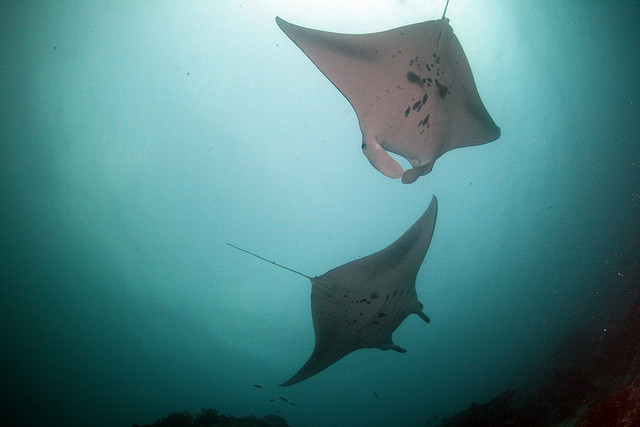Long before humans hopped onto airplanes to explore the far reaches of our planet, large sharks and rays were traveling between continents. These charismatic megafauna still undertake these planet-spanning journeys, making them some of the planet’s most cosmopolitan creatures.
Modern technology has not only given us the chance to travel from Austria to Australia or from Switzerland to Zimbabwe in less than a day, it has also given us the tools to track these amazing fish migrations. Electronic tags equipped with GPS, depth and temperature-measurement devices have become small enough to be attached to a large shark or ray without significantly impairing the animal’s movements. And satellites orbiting Earth can record this data when the animal surfaces or when the tag is automatically released after a certain time. Today we can track animals for months, when only few decades ago we could only catch occasional glimpses of them when snorkeling or diving. What have we learned? Let’s look at two particularly impressive studies:
In a 2014 study, researchers from the King Abdullah University of Science and Technology tagged manta rays in the Red Sea to study their migration and diving behavior. Tracking seven different animals for up to six months on the Saudi Red Sea coast, they found that the rays dived up to 1,417 feet (432 meters) deep. Interestingly, the majority of the deeper dives happened during the night. During the day, the mantas often swam in a shallow 33 feet (10 meters), not surprising since this is where the plankton they feed on lives. Another intriguing finding was that the rays seemed to be gliding long distances; fast ascents were often followed by extended periods of slow, probably passively gliding descent.
When tracking mantas for three to six months, the beginning and end points of their routes were between 2.5 and 105 miles apart (4 and 169 km). Likely, the mantas swam longer distances during these times, but they were still rather local ocean creatures.
So while the mantas’ diving is impressive, and their migrations are not inconsequential, the true cosmopolitans of the sea are the great white sharks. In a 2005 study, scientists from South Africa and the U.S. tagged great whites and identified them after long migrations by the ridges on their fins. One tagged shark swam from South Africa to Western Australia — a route of over 6,800 miles (more than 11,000 kilometers) — in just 99 days. This shark was a female, previously thought to inhabit a more localized coastal territory. The tagged sharks also reached a maximum depth of 3,215 feet (980 meters), a region engulfed in almost perpetual darkness.
I’ve not yet seen great white sharks in the wild, but I have seen manta rays on multiple occasions. Every time I encounter these giants it’s a memorable experience, yet it’s obvious that the few minutes I spend in their company are only a very brief glimpse into their lives. What are they doing when they glide away from the reefs? How deep do they dive? How do they socialize? Happily for all divers, science is answering more and more of these fascinating questions.

By guest author Klaus M. Stiefel

